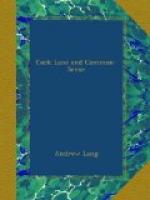Leaving the boys’ sworn evidence, and returning to the narrative with its gossip, we learn that Thorel boasted of his success, and said that, if he could but touch one of the lads again, the furniture would dance, and the windows would be broken. Meanwhile, we are told, nails were driven into points in the floor where Lemonier saw the spectral figure standing. One nail became red hot, and the wood round it smoked: Lemonier said that this nail had hit ‘the man in the blouse’ on the cheek. Now, when Thorel was made to ask the boy’s pardon, and was recognised by him as the phantom, after the experiment with the nail, Thorel bore on his cheek the mark of the wound!
This is in accordance with good precedents in witchcraft. A witch-hare is wounded, the witch, in her natural form, has the same wound. At the trial of Bridget Bishop, in the court of Oyer and Terminer, held at Salem, June 2, 1692, there was testimony brought in that a man striking once at the place where a bewitched person said the shape of Mrs. Bishop stood, the bewitched cried out, that he had tore her coat, in the place then particularly specified, and Bishop’s coat was found to be torn in that very place. {279a} Next day, after Thorel touched the boy, the windows broke, as he had prophesied. Then followed a curious scene in which Thorel tried, in presence of the maire, to touch the cure, who retreated to the end of the room, and struck the shepherd with his cane. Thereupon Thorel brought his action for libel and assault against the cure. Forty-two witnesses were heard, it was proved that Thorel had, in fact, frequently accused himself, and he was non-suited: his counsel spoke of appealing, but, unluckily, the case was not carried to a higher court. In a few weeks the boys were sent to their homes, when (according to the narrative) there were disturbances at the home of the younger lad. Thus the cure lost his pupils.




